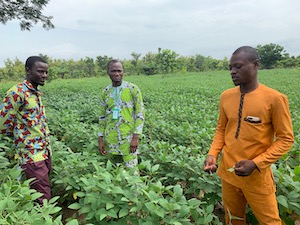 Climate finance is hot, and rightfully so. The threat is real, and the needs are towering. The good news is that there are investible solutions out there. As with any new field, the development of climate finance has been accompanied by a range of standards, taxonomies and metrics. For climate mitigation, a clear consensus seems to be emerging on emissions reductions as the preferred metric to be tracked by investors, however the jury is still out on the ideal standards for tracking the impact of climate adaptation, and it is only starting to deliberate on resilience projects.
Climate finance is hot, and rightfully so. The threat is real, and the needs are towering. The good news is that there are investible solutions out there. As with any new field, the development of climate finance has been accompanied by a range of standards, taxonomies and metrics. For climate mitigation, a clear consensus seems to be emerging on emissions reductions as the preferred metric to be tracked by investors, however the jury is still out on the ideal standards for tracking the impact of climate adaptation, and it is only starting to deliberate on resilience projects.
This difference in the pace of development of climate mitigation and adaptation standards has led to an unintended consequence: that the story of climate finance today is the story of climate mitigation. Less than 10 percent of all climate finance today goes to adaptation and resilience. This happens not because mitigation is more important than adaptation, but because the impact of mitigation projects is easier to track than that of adaptation projects. Simply put: what gets measured, gets managed.
The problem with too narrow of a focus on climate mitigation is that it does not take into account the fact that climate change is a challenge of livelihoods and social justice as much as it is an environmental challenge, especially for low-income populations and other vulnerable communities in the global South. Because climate change is not gender neutral, applying a gender (or JEDI for Justice, Equity, Diversity) approach to investments can increase the effectiveness of efforts to combat climate change and accelerate adaptive capacity. And vice versa: because climate change disproportionately impacts the lives of socially vulnerable people, investing with a JEDI lens can only work if it includes a holistic climate focus as a centrepiece.
Scaling up and mainstreaming climate adaptation and resilience is critical to ensuring that communities most vulnerable to climate change are not left behind. A smallholder farmer in South America or Africa would benefit, for example, from climate-resilient seeds, a smart irrigation system, soil rehabilitation or an emergency shelter for livestock. What needs to be done to channel more funding toward a more holistic approach to climate change?
Balancing standardization versus innovation
More standardization would lure more investments to climate adaptation and resilience solutions, but this can be an uphill battle.
The lack of clear, evidence-based definitions of resilience investments (e.g., healthcare, housing, gender equity, food security, employment, water) is a barrier for investors. While standards could boost credibility, they simultaneously risk inhibiting innovation, which is much needed given the high level of unpredictability about future climate change impacts. The underlying vulnerability of people and ecosystems as well as their ability to recover from climate shocks depends on many factors (e.g., physical, social, ecological, financial).
On the capital demand-side, the additional costs linked to demonstrating environmental impact in a rapidly changing and increasingly regulated context can be a stumbling block. Not all companies can afford to issue such instruments, undergo periodic external audits, deploy sizeable eligible portfolios and report in alignment with regulatory taxonomies. Therefore high transaction costs are seen as one of the key factors deterring firms from issuing green bonds.
Overcoming these roadblocks requires a more inclusive approach in building a framework for climate adaptation and resilience.
Three steps toward a “fit-for-purpose” approach
An inclusive, bottom-up approach needs to draw upon an understanding of the realities of communities most threatened by changing climate conditions. The poor and marginalized in emerging countries – who have limited economic and institutional capacities – are the most vulnerable to these changes, so the proportionality principle should be applied to create “fit-for-purpose” standards. Investors can put this in practice through three steps.
 First, it is imperative to start with a detailed diagnosis of the underlying assets. It is important to understand how partner financial institutions and their clients are affected by climate change and how they contribute to climate mitigation, adaptation and resilience solutions. Such an investment approach emphasizes the importance of financial sustainability and recognises that investments in climate resilience, mitigation and adaptation can be mutually reinforcing and socially beneficial. Several efforts and initiatives in the impact investing space aim to better understand the social dimension of climate resilience, such as the resilience index of 60 Decibels.
First, it is imperative to start with a detailed diagnosis of the underlying assets. It is important to understand how partner financial institutions and their clients are affected by climate change and how they contribute to climate mitigation, adaptation and resilience solutions. Such an investment approach emphasizes the importance of financial sustainability and recognises that investments in climate resilience, mitigation and adaptation can be mutually reinforcing and socially beneficial. Several efforts and initiatives in the impact investing space aim to better understand the social dimension of climate resilience, such as the resilience index of 60 Decibels.
Second, it is important to develop fit-for-purpose metrics that go beyond emissions reductions and suit the nature of the asset. For Incofin’s recently launched Water Access Acceleration Fund, for example, Incofin does not just track one metric, but a whole range, including the number of water businesses implementing a climate resilience strategy, the number of these businesses using carbon credits, volume of water reused, efficiency of water use and tonnes of CO2 emissions averted. These metrics are tailored to the chosen sector (in this case, water) and provide clear guidance for tracking the climate-related impact of the investments.
Finally, take the reality of the specific market into account. Standardized metrics and rigid frameworks developed in the global North sometimes fail to account for the diverse and specific needs of end clients in the South. A comprehensive, bottom-up approach must complement rigorous quantitative data with qualitative insights gained on the ground, with a human-centered lens that accounts for the needs and demands of end clients. The physical presence of an investment team in the countries in which investments are made enables a flow of feedback that allows for the development of products and metrics that take into account the unique needs of the local market.
While the inclusive finance sector widely acknowledges the climate adaptation gap in low-income countries, there is an urgent need to accelerate the flow of financial resources to support low-income populations at the front line of climate change. Failure to do so will lead to further social and financial exclusion. To avoid this, it is imperative to break silos and develop a holistic approach that recognizes that investments in climate mitigation, adaptation and resilience reinforce one another and create positive environmental outcomes, as well as promoting gender empowerment and other social benefits. The sector can play a key role in doing this at scale by drawing on more than two decades of experience in developing, tracking and delivering impact in a sustainable manner.
This article is by Noémie Renier, Partner and Head of Debt for Financial Institutions at Incofin Investment Management, and Kapil Kanungo, Incofin’s Private Equity and Fund Development Manager.
Incofin, the sponsor of this feature, is a leading impact investor headquartered in Belgium that has over USD 1.4 billion of private debt and private equity assets under management.
Similar Posts:
- MICROFINANCE EVENT: Sankalp Global Summit; October 19, 2023; Mumbai, India
- MICROFINANCE PAPER WRAP-UP: “Impacts of Microcredit Access on Climate Change Adaptation Strategies Adoption and Rice Yield in Kwara State, Nigeria,” by Adejoke Yewande Bakare et al
- SPECIAL REPORT: European Microfinance Week Is Almost Here!
- MICROFINANCE EVENT: Climate Investment Summit; June 28, 2023; London, UK
- MICROCAPITAL BRIEF: EBRD Loaning $5m to ING Finansal Kiralama for Leasing for Energy Efficiency, Renewables in Turkiye
